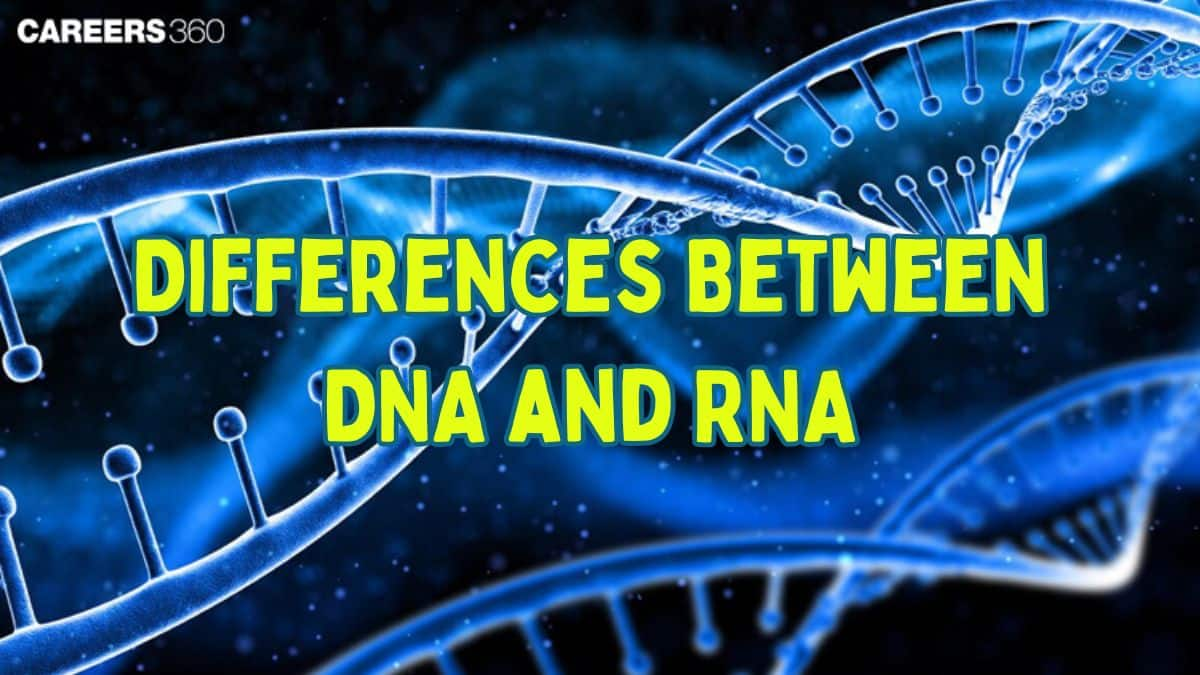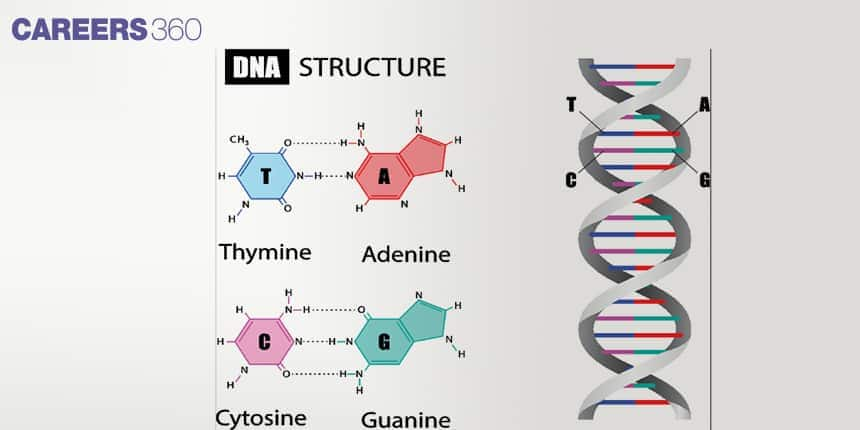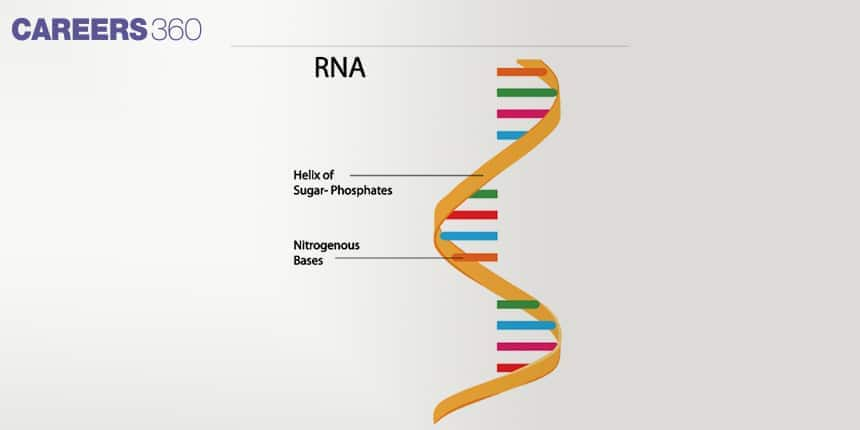Difference Between DNA and RNA: What Is the Difference Between DNA and RNA?
DNA and RNA are the nucleic acids that play important roles in genetics and cellular functions. DNA is the stable, double-stranded molecule responsible for storing genetic information. RNA is single-stranded and helps in protein synthesis. The difference between DNA and RNA is that DNA contains deoxyribose sugar, while RNA has ribose sugar. They differ in nitrogenous bases also.
This Story also Contains
- What is DNA and RNA?
- DNA vs RNA
- Structure of DNA
- Types of DNA
- Structure of RNA
- Types of RNA
- Functions of DNA and RNA
- MCQs on DNA and RNA

In biology, genetic material is present in two basic forms: Deoxyribonucleic Acid (DNA) and Ribonucleic Acid (RNA). The genetic material helps control the organism’s composition. This article includes DNA, RNA, the differences between DNA and RNA, the structure of DNA, the structure of RNA, and the functions of DNA and RNA. The difference between DNA and RNA is a topic of the chapter Molecular Basis of Inheritance.
What is DNA and RNA?
Genetic material is the hereditary substance of the organism. It carries all information which is specific to the organism. It is known as DNA or RNA. DNA is a double-stranded molecule storing genetic information. RNA is a single-stranded molecule. It performs many different functions in regulation as well as the expression of genes.
Nucleic acids are the most important molecules in life, providing the blueprints for all cellular processes. DNA and RNA represent the two major nucleic acids. They have an extremely important function in storing and passing genetic information. In synthesizing proteins that can perform functions for a cell. They represent the very basis of life itself for growth, development, and reproduction.
DNA vs RNA
There are quite some Differences Between DNA and RNA, at various levels such as chemically, structurally and also on a functional basis. It is one of the important differences and comparisons articles in Biology. The differences between DNA and RNA are tabulated below:
Features | DNA | RNA |
Sugar | Deoxyribose | Ribose |
Nitrogenous Bases | Adenine (A), Thymine (T), Cytosine (C), Guanine (G) | Adenine (A), Uracil (U), Cytosine (C), Guanine (G) |
Strands | Double-stranded helix | Single-stranded |
Functions | Stores the genetic information, replication of DNA, inheritance | Gene Regulation and Gene Expression , protein synthesis |
Location | Mainly in the nucleus, but also in mitochondria and chloroplasts | Nucleus and cytoplasm |
Stability | More stable due to deoxyribose and double-helix structure | Less stable, can degrade |
Synthesis | Semi-conservative replication | Process of transcription from DNA template |
Role in Protein Synthesis | Indirect role through storage and transmission of genetic code | Direct role in translation and regulation |
Structure of DNA
The DNA structure is composed of nucleotides, which consist of a sugar molecule, a phosphate group, and a nitrogenous base. These nucleotides are linked together to form long chains.
Deoxyribonucleic acid is a polymer of deoxynucleotides.
The pentose sugar in deoxynucleotides doesn't have the -O at C-2. Due to this fact, it is called the deoxyribose sugar.
DNA is a polymer of nucleotides. That means many nucleotides are linked with each other via a covalent bond to form a polymer.
The covalent bond that links the two nucleotides is known as the phosphodiester bond.
Hence, a polynucleotide chain is formed when many nucleotides are united through the phosphodiester bond.
DNA consists of two polynucleotide chains that are connected through hydrogen bonds.
The two polynucleotide chains are helically arranged around each other.
In a polynucleotide chain, the backbone is composed of sugar and phosphate, while the nitrogenous bases form hydrogen bonds.
Adenine forms two hydrogen bonds with thymine.
Cytosine is bonded to guanine through three hydrogen bonds.

Types of DNA
DNA is the genetic material of all living organisms, except for some viruses. It stores hereditary information. Based on its location and specific function. Types of DNA are the following:
A-DNA
A right-handed double helix that is shorter and more compact than B-DNA.
Dehydrated form of DNA, with 11 base pairs per turn.
Natural occurrence is rare, but conformation is found in dehydrated samples or specific DNA-RNA hybrid structures.
B-DNA
The most common form of DNA is with a right-handed double helix and 10 base pairs per turn.
The normal configuration is assumed by DNA under physiological conditions. It has a wide major groove and a narrow minor groove, giving a surface architecture that is well-suited to the binding of proteins.
It is present in most living cells under normal physiological conditions.
Z-DNA
A left-handed double helix with an alternating sugar-phosphate backbone.
Contains 12 base pairs per turn, and its formation is favored by some sequences and supercoiling.
Seen in vivo, especially in GC-rich areas or under high salt.
Structure of RNA
RNA is one of the most important biological molecules. It helps in major functions like coding, decoding, regulating, and expressing genes. RNA is a type of nucleic acid that carries genetic information. It is generally single-stranded and found in the nucleus as well as the cytoplasm of the cells. RNA acts as genetic material in some viruses.
The ribonucleic acid or RNA is also a polymer of nucleotides.
The pentose sugar of RNA has a -OH group at C-2.
It is also a polynucleotide chain wherein the nucleotides are linked with each other via the phosphodiester bond.
Unlike DNA, it is single-stranded and more reactive.
RNA contains uracil as one of the pyrimidines rather than thymine.

Types of RNA
Only some of the genes in cells are expressed in RNA. The following are the types of RNA, wherein each type is encoded by its own type of gene:
mRNA or messenger RNA, bears the message from DNA and makes the polypeptide chain in conjunction with the ribosomes.
rRNA or Ribosomal RNA, forms a main component of ribosomes where the mRNA binds.
tRNA is the smallest of the three major types of RNA. It contains about 70-90 nucleotides. It carries the correct amino acid to the place of protein synthesis.
snRNA - In eukaryotes, small nuclear RNA forms complexes with proteins for RNA processing.
Functions of DNA and RNA
Genetic material is responsible for storing and passing the information from one generation to the next. The two types of genetic material found in living organisms are DNA and RNA. Understanding their differences is important in the central dogma of biology, which explains the formation of DNA to RNA and then to proteins. While DNA stores the information, RNA helps in translating that information to proteins. The functions of DNA and RNA are listed below-
DNA Functions
It is the DNA that carries the specifications of everything genetic about life: development, functioning, growth, and reproduction.
There are many such specific DNA sequences, named genes, and each one of them codes for a particular kind of protein to carry out cell functions.
It replicates to ensure that each new cell gets an identical copy of the genetic information in the process of cell division.
This replication is significant in that it allows inheritance to take place, whereby genetic characters are transmitted from one generation to another.
RNA Functions
RNA plays a big role in translating the genetic information in the DNA into proteins (gene to protein) and does this through three types of RNA:
mRNA (messenger RNA) returns DNA information from the nucleus to protein synthesis-containing cytoplasmic ribosomes.
tRNA (transfer RNA) brings amino acids to the ribosomes and matches the mRNA codon with the correct amino acid.
rRNA (ribosomal RNA) forms the core of the ribosomes, complexes in the cell where proteins are made.
RNA molecules regulate gene expression at multiple levels that include transcriptional and post-transcriptional control. This gives control over gene expression to occur at the right time and in the right amount.
MCQs on DNA and RNA
Question: The number of hydrogen bond between A & T and G & C in a DNA double helix are
Answer: DNA (Deoxyribonucleic Acid) is the genetic material in most living organisms, except for some viruses. It stores hereditary information, which is essential for the growth, development, and functioning of all living organisms. In a polynucleotide chain, the backbone is formed by alternating sugar (deoxyribose) and phosphate groups, while the nitrogenous bases form hydrogen bonds between complementary strands. Adenine (A) pairs with thymine (T) through two hydrogen bonds, while cytosine (C) pairs with guanine (G) through three hydrogen bonds, creating the double helix structure of DNA. This arrangement allows DNA to replicate and transfer genetic information across generations.
Hence, the correct answer is option(3) 2,3
Question: Nucleic acid occupy _______% of total cellular mass.
10-15
3
5-7
70-90
Answer: Nucleic acids, comprising DNA and RNA, generally account for 5-7% of the total cellular mass in both prokaryotic and eukaryotic cells. This proportion can vary based on factors such as the cell type, developmental stage, and physiological conditions of the organism. For instance, actively dividing cells or cells with high metabolic activity may exhibit altered nucleic acid content to support their increased functional demands.
Hence, the correct answer is option 3) 5-7.
Question: The amino acid attaches to the tRNA at its:
5′ – end
3′ – end
Anticodon site
DHU loop
Answer: The amino acid attaches to the 3' end of the tRNA molecule at the terminal adenine nucleotide. This attachment occurs at the hydroxyl group (-OH) of the adenine ribose, forming an ester bond between the carboxyl group of the amino acid and the ribose sugar of the tRNA.
Hence, the correct answer is option 2) 3' – end
Also Read-
Frequently Asked Questions (FAQs)
DNA has deoxyribose sugar, and thymine base, and is double-stranded, while those in RNA are ribose sugar, uracil base, and single-stranded.
DNA is usually double-stranded whereas RNA is usually single-stranded.
In DNA, information storage happens to provide the genetic system and the dissemination of inheritance, while in RNA, information for the creation of proteins and gene expression is provided.
In DNA, ribonucleic acid is mainly produced in the cell nucleus and from organelles such as the mitochondria and chloroplasts. RNA is found in all cells, mainly in the cell nucleus and cytoplasm.
DNA is much more stable due to its deoxyribose sugar and a double-stranded helical structure, which provide it with a resistance to degradation.